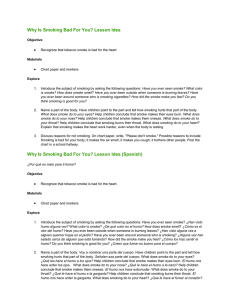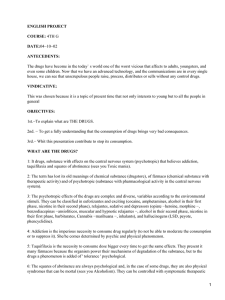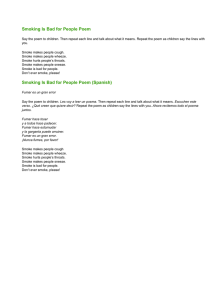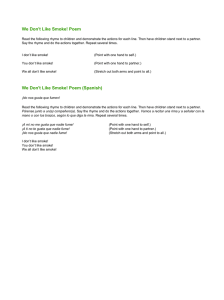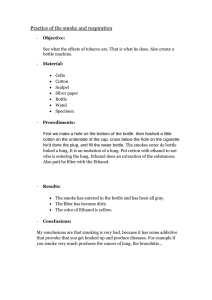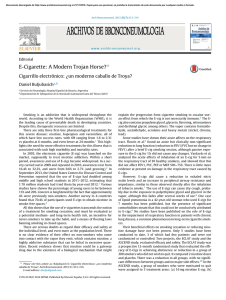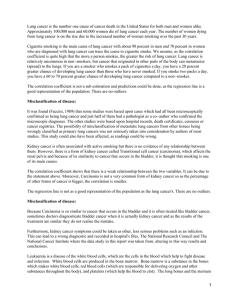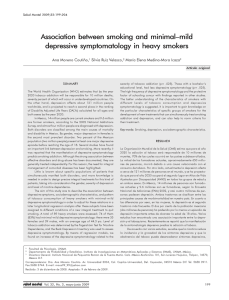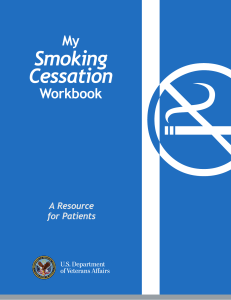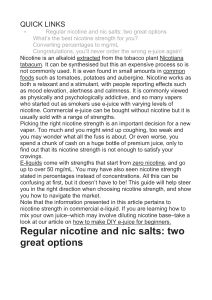Smoking cessation
Anuncio
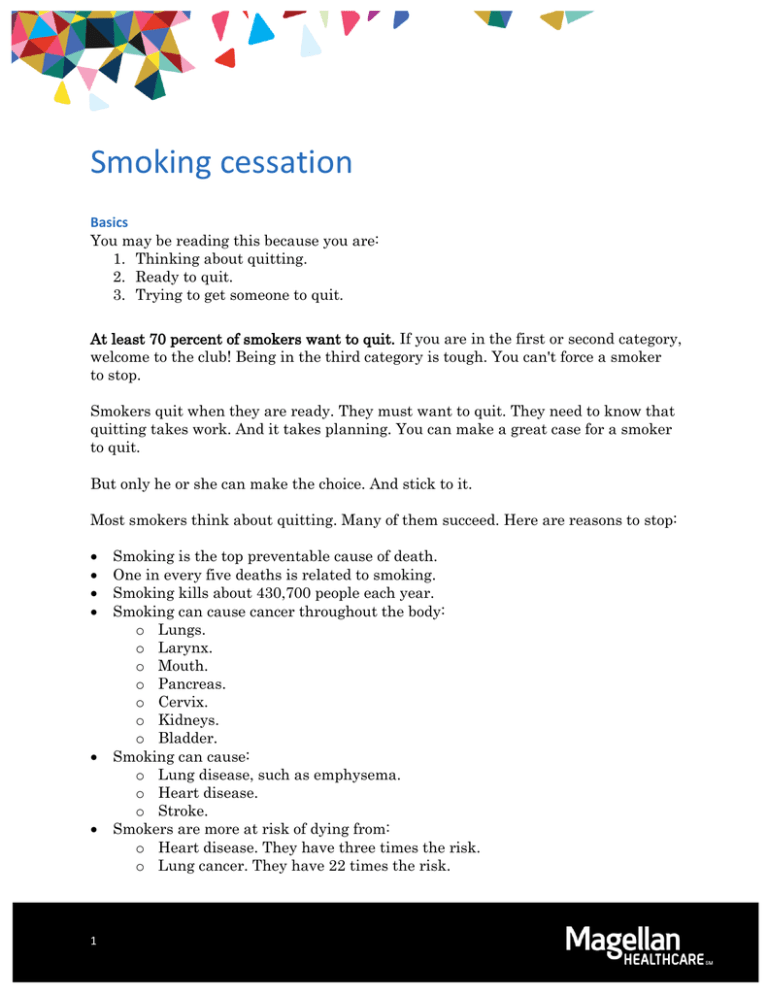
Smoking cessation Basics You may be reading this because you are: 1. Thinking about quitting. 2. Ready to quit. 3. Trying to get someone to quit. At least 70 percent of smokers want to quit. If you are in the first or second category, welcome to the club! Being in the third category is tough. You can't force a smoker to stop. Smokers quit when they are ready. They must want to quit. They need to know that quitting takes work. And it takes planning. You can make a great case for a smoker to quit. But only he or she can make the choice. And stick to it. Most smokers think about quitting. Many of them succeed. Here are reasons to stop: 1 Smoking is the top preventable cause of death. One in every five deaths is related to smoking. Smoking kills about 430,700 people each year. Smoking can cause cancer throughout the body: o Lungs. o Larynx. o Mouth. o Pancreas. o Cervix. o Kidneys. o Bladder. Smoking can cause: o Lung disease, such as emphysema. o Heart disease. o Stroke. Smokers are more at risk of dying from: o Heart disease. They have three times the risk. o Lung cancer. They have 22 times the risk. The good news? You reduce the risks when you stop. In a year, you cut in half your risk of death from heart disease. The longer you stay smoke-free, the lower your chance of dying from smoke-related causes. Nonsmokers can outlive smokers by seven years. So you can add as much as seven years to your life. Second-hand smoke can hurt nonsmokers. Every year it causes: o About 37,000 to 40,000 premature deaths from cardiovascular disease (according to the American Heart Association). o About 3,000 premature lung cancer deaths (according to the National Cancer Institute). o Up to 30,000 lower respiratory tract infections in children up to 18 months old. If you smoke at home, your children will have: o More respiratory infections. o Slower lung development. o More middle-ear disease. o Studies link second-hand smoke with SIDS (sudden infant death syndrome). And low birth weight. Let's face it. Smoking is a dirty habit. It stains your teeth. It makes your breath, clothes and surroundings smell bad. It fills ash trays with ugly, smelly butts. And it wrinkles your skin too soon. But you can quit. More than 50 percent of smokers have succeeded. Many of them tried stopping three or four times before they made it. So there is hope for just about any smoker. Sometimes the best way to stop smoking is to seize the right moment. You may find yourself in a situation that keeps you from smoking. A hospital stay, for instance. Take advantage of the situation. Decide to not smoke again. It could be your first step toward quitting for good. Key tips Tip 1 First-time smokers are often young people. About 90 percent of them are children or teen-agers. Nearly 3,000 of them become regular smokers every day. Tip 2 More than 75 percent of smokers fear withdrawal symptoms. They say this prevents them from stopping. Nicotine replacement therapy (NRT) can reduce those symptoms. This will make withdrawal far less troubling. NRT in combination with behavioral counseling can double the number of smokers who quit (according to the American Cancer Society). 2 Tip 3 The benefits of quitting are huge. They start right away after your last cigarette. The discomfort of quitting may obscure the benefits at first. Just 20 minutes after you stub out your last one, your blood pressure drops. And the temperature of your hands and feet rises to normal. Within eight hours, the carbon monoxide level in your blood drops to normal. And that's just the beginning. Forty-eight hours after your last cigarette, nerve endings start to grow again. You will enjoy your favorite foods more than you have in years. Two weeks to three months later, your circulation and lung functions improve. One to nine months later, you will see a decrease in o Coughing. o Sinus congestion. o Fatigue. o Shortness of breath. o Your lungs do their job better. This leads to fewer lung infections. Five years later, your stroke risk is greatly reduced. Ten years later, your risk of lung cancer death rate is half that of a smoker. Your risk of other cancers decreases. Such as mouth, kidney and pancreas cancer. Fifteen years later, your risk of coronary heart disease is no greater than a nonsmoker's. Tip 4 When you try to quit, don’t go on a smoking binge before you stop. You may think the last fling will tide you over. But you will increase your cravings for nicotine. This will make it nearly impossible for you to quit. It is better for you to decrease your smoking in before quitting. Specifics There are three top methods of quitting. They work more powerfully if you use them together. They are: Nicotine replacement therapy (NRT).Such as a patch, gum or nasal spray. Encouragement from friends or support groups. Behavior modification and other techniques. They help you handle the stress of quitting. And the urge to smoke. Other successful techniques include: o Stress reduction. o Hypnosis. o Acupuncture. Triggers Smokers should determine the triggers for lighting up. They can be: 3 Physical activities. Locations. Circumstances. Common triggers include: Waking up in the morning. Ending a meal. Drinking coffee or alcohol. Seeing someone light up. Studying. Relaxing in a particular place. Feeling stressed. Make a list of every possible trigger for you. One of your most important tasks will be to avoid as many triggers as you can. If you can’t avoid a trigger, try changing it. Waking up in the morning is a common trigger for a lot of people. You can't get rid of it. Brush your teeth as soon as you wake up instead of lighting up. Dealing with triggers is critical during the first three weeks. The urge to smoke is the greatest then. Cutting back Many people find it easier to quit if they cut back gradually. There are lots of things you can do if you choose this route: Switch to a cigarette with a lower nicotine level. Cut the ends off your cigarettes. You'll have less to smoke each time. Smoke a brand you don't like. Buy cigarettes by the pack. Not the carton. Make smoking inconvenient. o Don't smoke inside. o Don't carry cigarettes with you. o Don't keep a lighter or matches with your cigarettes. Make smoking uncomfortable. Smoke where it is: o Cold. o Hot. o Smelly. o Unpleasant. Smoke during even (or odd) hours of the day. Or after a certain time of day. Limit the number of places where you let yourself smoke. Pick a quit date. Tie it to a special day. Such as a birthday. Or anniversary. Or choose a weekend when you can plan favorite activities to keep you busy. Avoid 4 stressful dates. Such as moving day. Or April 15. Tell your best friends or relations about your quit date. Plan to stay busy. Map out your day to avoid as many triggers as you can. No matter what you do, you will have to battle the urge to smoke. Many things can decrease your urges: Throw away every cigarette and ash tray. If an ash tray was a wedding gift from your favorite aunt, turn it into a candy dish. Plan activities in nonsmoking places. Ask others not to smoke in your presence. Exercise. Keep healthy snacks nearby. Such as carrot sticks. You can handle them as you used to handle cigarettes. Plan an activity during a trigger time. Reduce stress through relaxation techniques or other methods. Get enough sleep. Eat a well-balanced diet. FAQs I have tried to stop smoking twice. Each time I do, I feel terrible. I start to tremble. I can't sleep. And I snap at the people I love. I start smoking again just to spare everyone around me. Cigarettes are addictive. The nicotine in cigarettes is just as addictive as heroin or cocaine. It creates a physical and emotional dependency. You feel awful when you quit because your body is in withdrawal. Your system will get rid of the nicotine. Your body adjusts. And you will start to feel much better. Your grouchiness will be temporary. But your health and mood (and the health and moods of those around you) will be improved. So nicotine is to blame? Nicotine is a poison. In a large enough dose, it can kill a person by paralyzing breathing muscles. Smokers don't consume lethal amounts of nicotine. But the smaller amount you take in gives you side effects. You feel awake and alert at first. Later, it can calm you. Nicotine can make you dizzy. Or feel nausea. It increases your heart rate. It lowers your skin temperature. And it reduces blood flow to your legs and feet. Nicotine can play a major role in increasing a smoker's risk of heart disease and stroke. My girlfriend smokes menthol cigarettes. She thinks they're safer than normal cigarettes. Is she right? No. In fact, she may be increasing her risk. Menthol cigarettes create a cool sensation in the throat. So a smoker may inhale more deeply and hold the smoke inside longer. This gives dangerous chemicals more time to do their damage. 5 Won't I be better off with chewing tobacco or snuff? No. Smokeless tobacco contains nicotine. It is the same addictive drug found in cigarettes. On average, snuff dippers consume 10 times the amount of cancercausing substances that cigarette smokers consume. People who use smokeless tobacco are likely to get cancer of the mouth, gums, larynx and esophagus. They have tooth loss, bad breath, discolored teeth and gum disease. What is nicotine replacement therapy? Nicotine replacement therapy (NRT) gives smokers medicine with nicotine. But without the harmful components found in cigarette smoke. NRT comes in the form of gum, skin patches, inhalers or nasal spray. NRT makes it possible for smokers to reduce their intake of nicotine. So NRT can lower and sometimes get rid of withdrawal symptoms. NRT works best when used with other methods of quitting. Especially those addressing psychological dependence. Learn more about smoking cessation Websites The American Heart Association offers information about smoking and heart disease: www.americanheart.org Information on lung diseases: www.lungusa.org Agencies and Associations American Cancer Society National Home Office 1599 Clifton Road, NE Atlanta, GA 30329 (800) 227-2345 (24-hour information line) www.cancer.org National Cancer Institute Public Inquiries Office Suite 3036A 6116 Executive Blvd., MSC8322 Bethesda, MD 20892-8322 (800) 4-CANCER (422-6237) www.cancer.gov This document is for your information only. It is not meant to give medical advice. It should not be used to replace a visit with a provider. Magellan Health does not endorse other resources that may be mentioned here. 6
